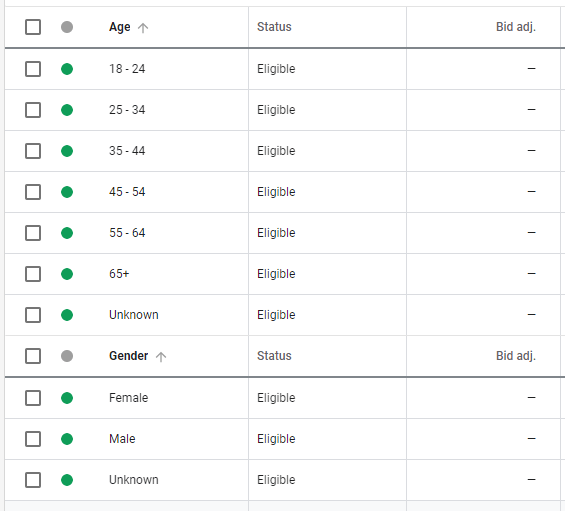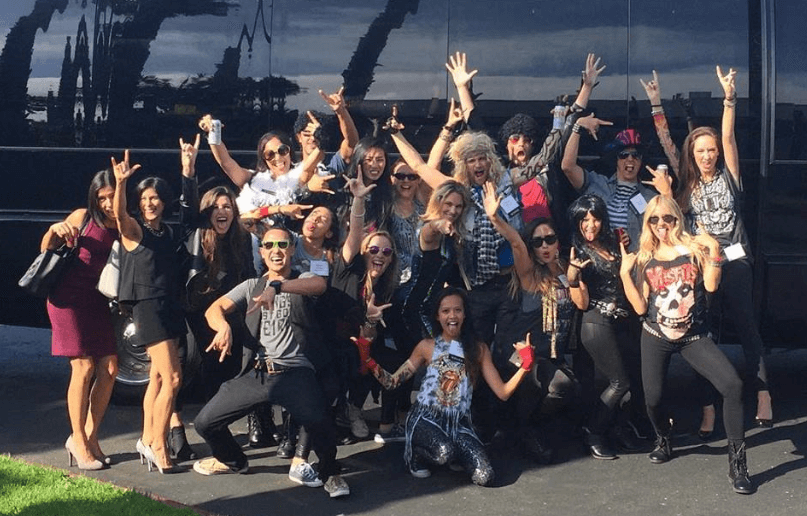The Facebook ad auction is competitive and hard to break into without experience and skill. Still, the return can make your effort worthwhile. Below, we will break down Facebook’s many ad options that can help to support your goals.
First, You Must Define Your Goals.
Every business wants to increase revenue, but there are many viable approaches and performance metrics to consider along the way. Are you focused on gaining first-time customers? Would you prefer to retain existing customers and stay top of mind? What about raising your brand awareness or driving sales of a specific product or service?
Facebook Ads offer an array of exciting capabilities, but in order to effectively leverage the platform, you must clearly define your marketing objectives first.
How do you plan to achieve your goals?
Facebook Ads focuses on placing your products and services in front of an audience, but it takes planning and sophistication to ultimately be successful.
You can start by answering some important questions.
Do you have a clear customer persona, attractive pictures of your products, and an effective email drip to nurture leads? Do you have holiday-focused sales pushes, a seasonal cycle, or steadily sell throughout the year? How do you differentiate yourself from your competitors?
Facebook doesn’t answer these questions for you.
What Facebook does offer is a platform for leveraging your answers to these questions by testing, improving, and targeting messages to your ideal customer at the right time. If you have existing customer data, you can use it to supplement your audience-targeting efforts on Facebook and other platforms. Like any Paid Media campaign, you cannot enter blind.
Facebook Ads Basic Structure
Facebook ad accounts have a very straightforward hierarchy. Each campaign has an objective. Then, each campaign contains at least one ad set, which hold specific targeting options and individual ads.
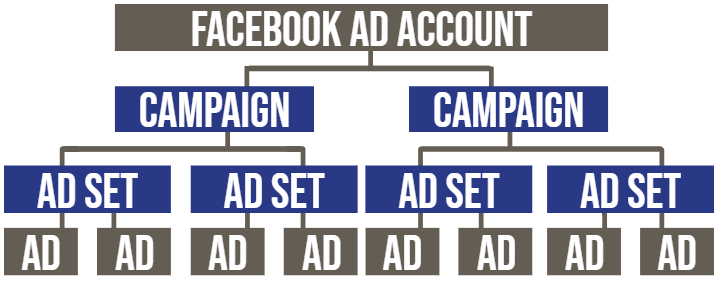
Do Facebook campaign objectives support your business’ goals?
When creating a new campaign, you are required to choose an “objective”: a way to communicate your specific goal or set of goals to Facebook Ads. To guide the structure of your overall Facebook Ads strategy, you need to first identify what you want out of advertising on Facebook and which objectives can give you those results.
Each objective will give you the most effective options for achieving your Facebook advertising goal(s). For example:
 If you choose the Video Views objective, future options will be presented under the assumption that you want the most individual 10-second video views at the lowest cost to raise product or brand consideration. You will not be able to show non-video ads in this campaign.
If you choose the Video Views objective, future options will be presented under the assumption that you want the most individual 10-second video views at the lowest cost to raise product or brand consideration. You will not be able to show non-video ads in this campaign.
 If you select the Traffic objective, Facebook Ads will require you to choose whether you want to drive people to your website or engage with your app. It will give you the option to use multiple types of ads, but you will not be able to show the ads anywhere except for Facebook and Instagram proper, since these are the most effective placements for achieving this goal.
If you select the Traffic objective, Facebook Ads will require you to choose whether you want to drive people to your website or engage with your app. It will give you the option to use multiple types of ads, but you will not be able to show the ads anywhere except for Facebook and Instagram proper, since these are the most effective placements for achieving this goal.
How are objectives related to overall marketing goals & strategy?
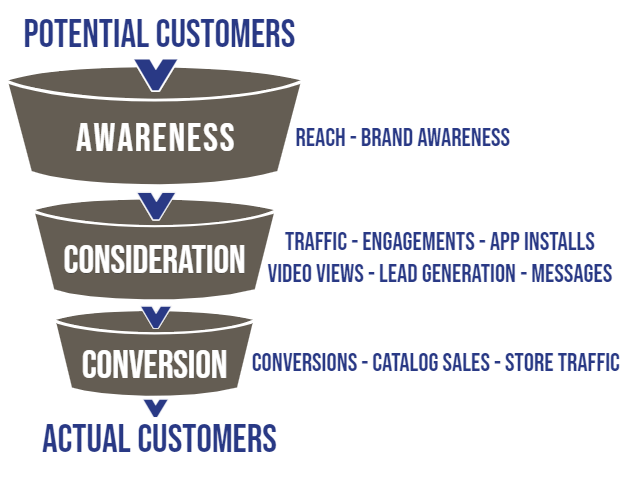
When you examine your business goals and fulfillment strategies, consider whether they would be supported by any of Facebook Ads’ potential objectives (outlined above). If two or more have strong congruence, and especially if they are in separate parts of the funnel, then Facebook advertising might be a good fit for your business.
Of Facebook’s three core objectives, each is focused toward a different segment of the marketing funnel and a distinct group of potential customers. Every individual objective supports a specific action and goal.
Here’s a brief overview of each campaign objective: what it does, what actions and goals it supports, and any important factors to be aware of.
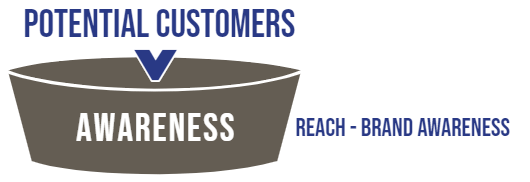
Awareness objectives are, as the name implies, focused on helping potential customers know about your business’ existence and offerings.
They are particularly good fits for strategies and goals that include bringing more prospects into the funnel or widening awareness.
- Reach: Optimizes for the maximum number of people seeing your ads, with control over the maximum times a person sees your ad. This can boost awareness of your brand over a specific area.
- Brand Awareness: Shows ads to the people who are most likely to remember seeing them, using the ‘estimated ad recall lift’ metric or insights from a brand lift study as a KPI. This more effectively promotes awareness of your brand among a specified subset of your target audience.

Consideration objectives are used to position your business as a viable option in the minds of customers, putting your offerings into their consideration set and establishing a relationship.
These objectives work very well with strategies or goals involving a longer consideration phase or centered around the establishment of a strong customer-business relationship, even if you plan to follow up with prospects through another platform.
- Traffic: Maximizes the amount of potential customers visiting your website or app. This promotes engagement and can help build a relationship, but can get expensive.
- Engagements: Designed to get visibility for your Facebook Page or post. This can be used to promote post engagement overall, Page likes, offer claims, or event attendance.
- App Installs: Promotes app installations or events on your app, or specifically optimizes to attract your highest-value customers. This drives use of your app, which builds a relationship and can improve user experience.
- Video Views: Optimizes for the most video views at the lowest cost. This ensures the highest number of people watch your video and resonate with your brand.
- Lead Generation: Encourages filling out and submitting a form with customer information to create a lead. This allows you to filter for truly interested leads, and contact them later with personalized messaging.
- Messages: Promotes communication with your business’s Facebook page via Facebook messages. This can build an ongoing relationship and identify engaged prospects for future targeting, but it’s better to use this only if you have a Messenger drip and/or dedicated staff.

Finally, conversion objectives focus around securing an action from your potential customers.
Such objectives are useful for almost every business that wants to secure sales, especially when paired with at least one consideration or awareness objective to bring prospects into the funnel.
- Conversions: With accurate targeting, existing prospects, and enough data, this objective can very effectively drive sales or other valuable actions.
- Catalog Sales: Typically used for ecommerce, this objective encourages purchases of products that a prospect has previously viewed or shown interest in by remarketing with dynamic ads. This pairs especially well with consideration campaigns that drive traffic to product pages and with relationship-based strategies.
- Store Traffic: Reaches people within a specified distance of one of your physical locations to drive foot traffic and in-store sales. This can be used to reach people who are actually in a position to buy, target current or new customers, or promote exclusive deals found only in stores.
Will Facebook’s audience targeting options let you reach your ideal customer?
Probably, but Facebook Ads has a few limitations you need to know about.
How flexible is Facebook’s audience targeting?

Unlike some other sources of paid media, Facebook Ads has very detailed audience targeting. This is because Facebook simply knows more about individual users than other platforms, both in terms of interests, actions, and demographics.

If your goals include reaching narrow or niche audiences, then Facebook Ads could be a great match. Wider audiences also work well, especially if you have a higher budget and get enough ad engagement to provide data for optimization.
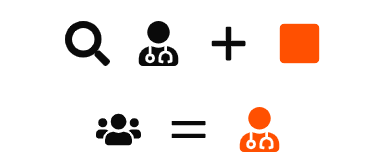
For example, you could target your “evolution of the guitar” graphic tee shirt to young people who play the guitar or listen to guitar music, and are either interested in science or majored in science in college, by setting this audience at the ad set level.
If you already have customer data, it is easy to securely add the information to your Facebook advertising account and use it to target leads or past converters from other sources.
Before you invest in Facebook Ads, it is important to know which limitations may apply to your business.
For example, certain products cannot be combined with specific audience types.
- Ads for jobs, insurance, housing, and other protected categories cannot be targeted by gender, age, racial group affinity, or other audience types which can be considered discriminatory targeting.
- Individual countries can also disallow or restrict ads for specific products. For example, you cannot promote or reference alcohol to users in Russia or Norway, and addiction treatment ads targeted within the United States must apply for permission to advertise.
- Facebook cannot be used to promote certain products at all. For example, if your business sells tobacco, prescription drugs, weapons, adult products or services, surveillance equipment, or illegal products, then you cannot advertise these on Facebook.
Targeting itself, while highly detailed, still has a few restrictions.
- Audience targeting is based off of self-reported data and user behavior. Since some groups – whether interest, demographic, or other affinity – are less likely to identify themselves on Facebook, you will not be able to capture every potential member of some audiences.
- You cannot target a group with a total audience size of under 1,000, but you can put together multiple small groups in one ad set.
- You cannot differentiate performance by specific audience segment within a single ad set; Facebook will only give you data for the entire ad set’s target audience as one group. For example, if you are selling t-shirts to science-loving musicians, you will not be able to tell whether guitarists or pianists buy more shirts if both segments are within one ad set.
- This presents a potential problem for the few advertisers who rely on very specific audiences (under 1,000 members). If each audience is too small to target in individual ad sets, you cannot effectively test them against each other.
How can different ad formats support your goals?
There are many ad formats; these three are the most common, but Facebook Ads offers an incredible amount of variety in potential ads. From getting eyes on your coupon by Boosting your Page post, to driving e-commerce product discovery through mobile-only Collection ads, the range of formats could be its own guide.
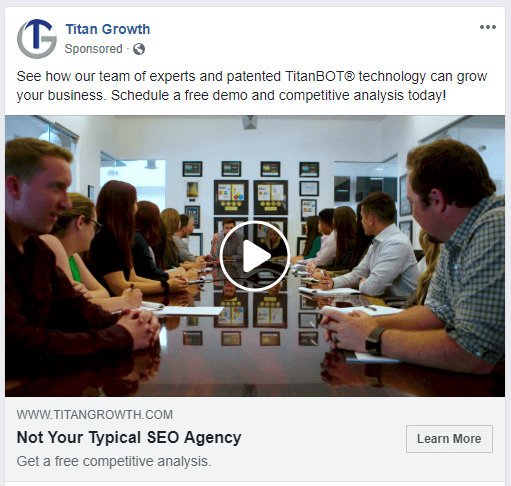
Video ads are among the most effective at raising awareness and securing conversions. However, each of these goals requires the video itself to be very different.
- Higher-funnel video ads, using an objective like Brand Awareness or Video Views, need to grab the viewer’s attention quickly with a hook that doesn’t rely on brand knowledge. If your goal is building a relationship with your audience, you can use video ads to tell a powerful and resonant story.
- Lower-funnel video ads can rely more on existing familiarity with brand to build a stronger connection. If your goals are to nurture existing customers, you can target individuals based on if they’ve seen a higher-funnel video and continue the “story”. Or, if your goal is to secure conversions, you can use these ads to take existing brand affinity and make a compelling pitch for a purchase.
- In-stream video ads, which appear during the streaming of longer videos, can be very useful for the goals of improving brand awareness and strengthening relationships. If your content is entertaining, the audience will remember it and your brand. However, they are unlikely to convert, since that requires closing the video.
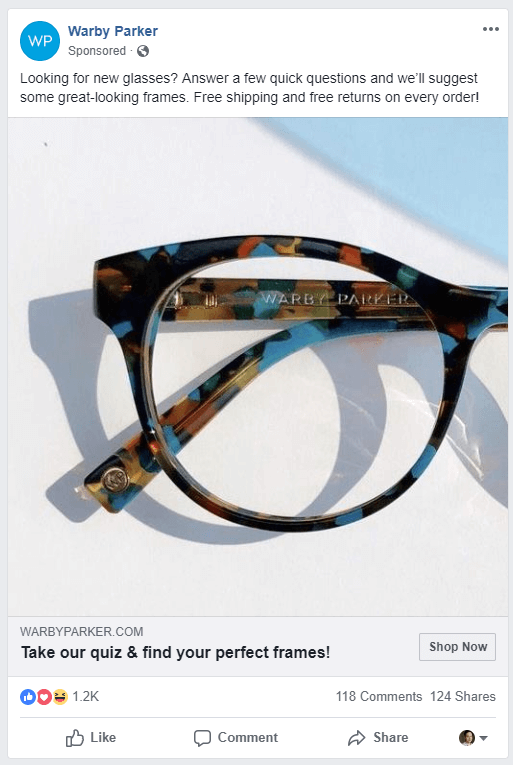
Image ads have the lowest barrier to entry and are the most “classic” type of ad. However, unlike video ads, they perform best when supporting lower-funnel goals such as consideration and conversion objectives.
- Image ads are less aggressive than video ads, as they hone in on something specific, such as an ecommerce product or a feeling. This means that they often rely on existing brand relationships to catch a user’s interest.
- Alternatively, image ads can be used to support a brand awareness goal if they are simple and displayed regularly, giving potential customers a sense of familiarity. This strategy, however, runs the risk of not improving ad recall lift.
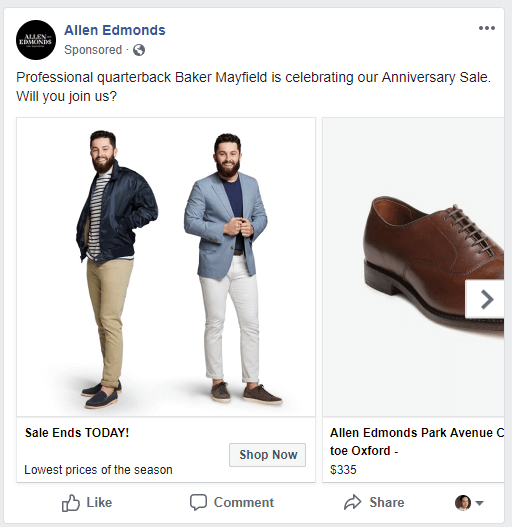
Carousel ads, which allow audience members to swipe between multiple images, are effective if your goals are to drive conversions or strengthen an existing brand relationship.
- On Instagram, carousel ads look functionally identical to non-advertisements. This makes them especially effective at targeting younger audiences, which use Instagram more frequently.
- Carousels give the advertiser an incredible amount of flexibility in image choice and ordering. The order of images can be either chosen or automatically optimized based on performance.
- Carousel ads can be used to support many goals. For example, if your goal is to tell a compelling brand story, a carousel ad’s images can walk a prospect through your history. Or, if you want to raise whitepaper downloads or product sales, you can highlight multiple selling points or key benefits.
- On the other hand, you can connect your carousel to your e-commerce database and display actual items which are for sale and in stock.
Are Facebook ads right for your business?
Facebook ads can be extremely effective with the right information, planning, and a sophisticated strategy, but not every company is prepared to manage Facebook alone. It’s up to you to decide if your company can benefit from Facebook Ads and is ready to open up a new channel to support revenue and profit growth.
Titan Growth is a Facebook Certified Buying & Planning Professional agency with years of experience in campaign strategy, goal-oriented advertisement, and precise customer targeting. Contact us for a free consultation to see how your business could benefit from a partnership with our award-winning agency.













